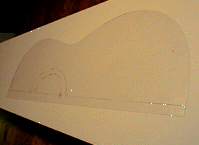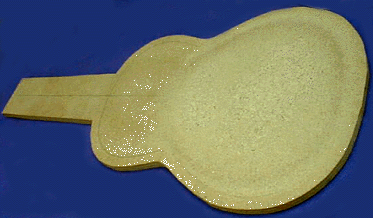
The Traditional Spanish Method of Classical Guitar Construction
What is considered traditional Spanish guitar construction is a complex topic. I have summarized 4 of its most important elements.
1. The Spanish Method is characterized by an integrated neck-body construction. Such construction displays an extension of the neck--called the"foot"--inside the soundbox which is glued to the interior back of the guitar. This design makes the neck-body connection very strong and ensures a powerful sound. The presence of a Spanish "foot" shows that the guitar was built by the Spanish Method not by the dovetail method which simply adds the neck to a completely assembled soundbox.

Here is a roughly cut neck which I have constructed. My finger indicates the portion of the neck called the "Spanish Foot".

Here we see the "Spanish Foot" inside of an assembled guitar.
2. The Spanish Method uses fan bracing as opposed to X-bracing or ladder bracing. Steel string guitars generally use an X-bracing to withstand the tension of the steel string which are 2-1/2 to 3 times higher tension than the nylon strings used on a classical guitar. Ladder bracing is currently used on cheap Asia plywood guitars. In the early 19th century ladder bracing was used on the guitars of the day which were considerably smaller in size.

This is a photo of a flamenco soundboard I am making. It has a very typical 5-strut face bracing. My finger is touching the "contra puente" which is a thin, wide brace which stiffens the area below the bridge.
3. The Spanish Method uses a domed soundboard (especially the lower bout). You can see the sight dome across the lower bout of the guitar by setting the edge of a straight piece of paper or cardboard on the soundboard. Without such a domed top the guitar will not be as loud or project as strongly.

The dome in this top is evidenced when I put a ruler across the lower bout.
4. The Spanish method uses a "plantilla" (which is simply a template of one-half of the guitar face) to establish the outline of the soundboard. Then, the braces are glued onto the soundboard while it is held in a scooped-out work board called a solera. By gluing the braces to the soundboard while in the solera the luthier is able to construct a domed soundboard. Finally, the face, sides, neck and back are put together on an assembly board called a molde or patrón. (All of these operations are extensively shown in my video Classical and Flamenco Guitarmaking with Benito Huipe.)

Here is a hard to see clear plastic plantilla (1/2 template of a soundboard).

This is a "solera" which is used to assemble the soundboard. The large lower area is slightly scooped out so I can build a dome into the soundboard.

Here we see how deep the scooped-out section is of the solera. The ruler shows that the solera gradually deepens to about 3mm.
Read another article:
"Handmade" vs Factory Made
Return to Fernandez Music Home Page